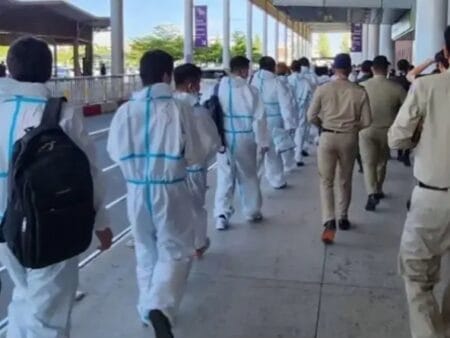Recent discussions within the Arab League in Cairo centered on a formal rejection of a proposal, reportedly from former U.S. President Donald Trump, concerning the relocation of Palestinians from Gaza.
The gathering, which included representatives from nations considered key allies of the U.S. such as Egypt, Jordan, Saudi Arabia, the UAE, and Qatar, served as a strong message against the concept of transforming Gaza.
The plan, perceived by some as originating from an imperialistic viewpoint, hinges on a large-scale displacement of Gaza’s inhabitants, a goal unmet even after a prolonged and destructive military campaign.
Furthermore, its feasibility is questionable without the support of neighboring Arab countries, which regard the widespread expulsion of Palestinians as a potential destabilizing factor.
The declaration, made relatively early in Trump’s term, has been interpreted in various ways.
‘Ludicrous declaration’
One interpretation is that it reflects a belief that Palestinians have been subdued and that Arab nations lack the strength to oppose what some see as a disregard for their rights and autonomy.
Another perspective suggests the announcement was intended to benefit significant campaign contributors.
Trump has a long and extensive domestic and international agenda and did not want to inherit a meaningless war with little strategic value
During his presidential run, Trump reportedly received substantial financial support from pro-Israel groups and individuals.
Some suggest that this support influenced his policies regarding Israel, similar to the recognition of Jerusalem as Israel’s capital and the relocation of the U.S. embassy.
However, some analysts question the seriousness of the proposal, citing Trump’s history of unconventional statements and actions.
Examples include suggestions regarding Greenland, Canada, and the Panama Canal, which have been widely viewed as outside the norm for a head of state.
Despite the controversy, Trump has reportedly reiterated his stance on Gaza.
Another view is that the announcement, coinciding with a visit by Benjamin Netanyahu to Washington, was an attempt to hinder the Israeli prime minister’s efforts to resume military actions.
Reportedly, the position surprised even some within the administration, as it had not been previously discussed.
Follow Middle East Eye’s live coverage of the Israel-Palestine war
According to this interpretation, Trump’s proposal aimed to remove not only Hamas but also the entire Palestinian population from Gaza.
Throughout his presidential campaign, Trump had reportedly urged Netanyahu to decisively conclude the conflict in Gaza. However, the stated objectives had not been achieved. Despite a prolonged military campaign, resistance persisted.
According to this reading, Trump has a long and extensive domestic and international agenda and did not want to inherit a meaningless war with little strategic value that would also derail his ambitious programme.
Bailing out Netanyahu
Another perspective suggests that Trump’s actions are rooted in negotiation tactics.
Drawing from principles outlined in his book, The Art of the Deal, some believe Trump is employing a maximalist position to pressure concessions, aiming to achieve through political means what military efforts have not.
Gaza ceasefire: Palestinian resilience prevails in face of Israeli genocidal war
Read More »
The conflict’s primary objectives included the release of Israeli captives, the elimination of Hamas, and the removal of Hamas from power in Gaza.
As these objectives remained unmet, and the conflict became protracted, Israel ultimately accepted a plan that incorporated elements of Hamas’s demands.
The plan, involving a phased release of captives and prisoners, a ceasefire, troop withdrawal, and humanitarian aid, was reportedly signed under pressure.
It calls for a three-stage process, each phase lasting 42 days, culminating in the release of all Israeli captives, dead or alive, in exchange for thousands of Palestinian prisoners, including around 600 serving life sentences.
Additionally, the agreement, which took effect on 19 January, mandated a permanent ceasefire after the second phase, the complete withdrawal of Israeli troops from Gaza, and the delivery of massive humanitarian aid, including food, water, fuel, tents, and medical supplies. It also outlined a genuine plan for Gaza’s reconstruction within five years.
Meanwhile, Netanyahu faces pressure from both the U.S. administration and right-wing partners within his government.
Political tensions have arisen, with some officials threatening to leave the coalition over the ceasefire plan, potentially destabilizing Netanyahu’s government.
Amid these complexities, Trump’s proposal has been interpreted as an attempt to support Netanyahu while also pressuring Arab nations to accept Palestinians from Gaza.
The alternative, according to Trump, would be to propose a plan that achieves the objectives of disarming Hamas and removing it from Gaza.
‘Dangerous precedent’
However, such a proposition threatens to destabilise not only these countries but the entire regional order.
Egypt, for instance, has a delicate peace agreement with Israel. Transferring a million Palestinians from Gaza to the Sinai may relieve Israel of its obligations as an occupying power, but it would create serious security and social challenges for the Egyptian regime. The Egyptian army, the country’s most powerful institution, is unwilling to manage this crisis, as Palestinians would resist forced displacement.
For many analysts, one of the most striking aspects of the Arab League’s proposal was the publication of a 91-page reconstruction plan for Gaza
Similarly, Jordan fears that accepting Palestinians from Gaza would set a precedent, potentially leading to the forced transfer of Palestinians from the West Bank.
This would pose an existential threat to the Hashemite Kingdom, endangering its delicate demographic balance. And thus, Jordan is fiercely against this proposal because it threatens its survival and could unravel the fragile stability of the kingdom itself.
Therefore, in order to counter Trump’s outlandish proposal, America’s Arab allies, including Egypt, Jordan, Saudi Arabia, and the UAE, held an emergency summit in late February in Saudi Arabia and agreed upon a detailed plan for Gaza’s future. Even the Palestinian Authority was excluded from this meeting.
This informal meeting was followed by a formal Arab League session in Cairo on 4 March, which issued an official statement rejecting Trump’s Gaza displacement proposal outright. Instead, it offered a roadmap for Gaza’s rehabilitation and reconstruction.
The final communique called for the immediate implementation of the ceasefire agreement’s second and third phases, including the complete withdrawal of Israeli troops from Gaza and the large-scale resumption of humanitarian aid to its suffering population.
It also demanded a lifting of the siege on Gaza and reaffirmed the need for a political resolution within the two-state paradigm.
Reconstruction plan
As for the Israeli and American demand to remove Hamas from power in Gaza, the Arab plan adopted the Egyptian proposal to create a commission of technocrats to manage Gaza for a six-month interim period under the auspices of the Palestinian Authority (PA).
The Egyptians had negotiated this proposal weeks earlier with several Palestinian factions, including Hamas and Fatah.
Since Israel rejected the PA’s return to Gaza, the plan proposed a period of rehabilitation and reforms to be adopted by the PA, including the training of its forces by Egypt and Jordan, after which it would assume responsibility for Gaza’s security.
The issue of disarming Hamas – an idea that Hamas, Islamic Jihad, and other resistance groups refuse to even discuss – was addressed only vaguely in the final communique. The document proposed placing all weapons under a single authority, presumably the PA, effectively nullifying the resistance, as the PLO and PA renounced armed struggle under the 1993 Oslo Accords.
The statement also called for a UN Security Council resolution to authorise an international peacekeeping force in Gaza – a proposal firmly rejected by Hamas and other resistance groups. Hamas and Islamic Jihad spokespersons stated that any foreign troops in Gaza would be considered an occupying force and treated as such.
Still, for many analysts, one of the most striking aspects of the Arab League’s proposal was the publication of a 91-page reconstruction plan for Gaza.
The document provided a remarkable level of detail on how Gaza would be rebuilt and rehabilitated, outlining a three-phase plan over five years.
The first six-month phase would focus on settling displaced Palestinians in temporary housing such as tents and caravans in seven designated areas.
The second and third phases, lasting three and two and a half years respectively, would focus on full-scale infrastructure development, including schools, universities, hospitals, roads, electricity plants, desalination facilities, and residential housing of varying densities.
The plan also included markets, government buildings, parks, hotels, tourist sites, and industrial zones. This level of detail, complete with maps, served as a direct refutation of Trump’s claim that displacement was necessary for Gaza’s reconstruction.
The reconstruction plan estimated the total cost at $53bn, with $3bn allocated for the first phase, $30bn for the second, and $20bn for the third. The document also called for an international donor conference to be convened soon in Cairo.
Competing interests
In a game of cards, players try to conceal their hands in the hope of outplaying their opponents. But in this geopolitical game, the various actors are laying their cards on the table.
The Israelis and their American allies seek to expel the Palestinians from Gaza – an elusive goal that has failed despite 15 months of genocide waged by Israel.
So, how does Trump intend to achieve it? He has ruled out using force, while his veiled threats to Arab regimes have been ignored as they see his demands as a threat to their own survival.
Though Arab regimes do not want a direct confrontation with Trump, they are equally unwilling to dig their own graves. They hope to pique his interest through arms and commercial deals or by offering him other political victories, such as a normalisation pact, akin to the Abraham Accords.
In their statement, they even dangled the prospect of recognising and normalising ties with the Zionist state, provided there is a viable path – though not necessarily an immediate implementation – towards a two-state political settlement.
Conversely, the current composition of the Zionist regime believes that with Trump in the White House and surrounded by the most Zionist and messianic administration in history, it may be able to achieve its maximalist political objectives.
These include eradicating resistance movements in the region and expelling as many Palestinians as possible to resolve its demographic problem and fabricate a Jewish majority – all while continuing to claim itself a democracy in a Greater Israel.
It further seeks to incapacitate Iran’s nuclear programme, force normalisation deals on Saudi Arabia and other Muslim-majority states, restore its lost deterrence and cement its regional hegemony – a staggering list of ambitions.
Inevitable defeat
If Netanyahu and his Zionist allies in the US insist on pursuing this ruthless campaign, they will have to persuade Trump to prioritise their belligerent objectives.
If Netanyahu and his Zionist allies in the US insist on pursuing this ruthless campaign, they will have to persuade Trump to prioritise their belligerent objectives
However, in his final term, he has little time to dismantle what he considers the US deep state – an entity he views as obstructing his domestic and international agenda.
Trump’s threats, hubris, and bombastic rhetoric will not compel others to bow to his wishes. If he resorts to hard power in Gaza, he will face fierce resistance – not only from traditional opponents of American policy in the region but also from pro-American regimes that view his pronouncements as dangerously destabilising.
These dynamics will inevitably derail Trump’s broader ambitions to reshape American society and the international order under his so-called “America First” agenda.
Like his predecessors, he will find that attempts to reshape geopolitical realities in the region through the barrel of a gun will only end in utter failure.
And if The Art of the Deal has taught us anything, it is that there is nothing Trump detests more than the sting of failure and the taste of defeat.










